
We are celebrating 15 years — and counting — of stories that are deeply researched and deeply felt, that build a historical record of what the city has been.
We are celebrating 15 years — and counting — of stories that are deeply researched and deeply felt, that build a historical record of what the city has been.
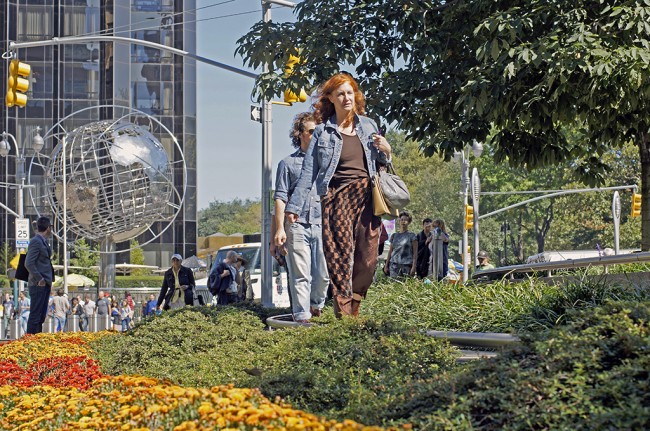
Karen Finley at the helm, circumnavigating Columbus Circle | photo by Justin Liu, Columbia University GSAPP
Emerging from the underground to Columbus Circle, Manhattan’s premiere roundabout, can disorient even the seasoned urbanite. As a recognized point from which distances are measured in New York City, it is a radial hub that emanates the tensions of urban mobility and economy above and below the ground — it is surrounded by the Time Warner and CNN towers. Personally, I tend to avoid the place whenever possible.
On the warm Saturday afternoon of September 26th, however, I joined a group of artists and architects gathered for a tour led by performance artist Karen Finley. “Mandala: Reimagining Columbus Circle” is one of many artist-led, participatory walks organized by Elastic City, an organization founded by Todd Shalom dedicated to the walk as art form. Finley’s walk, part of a twelve-day Elastic City Walks festival, was co-organized by Columbia University’s Graduate School of Architecture, Planning, and Preservation (GSAPP).
Karen Finley, an NYU Tisch School of the Arts professor, is an artist whose work has sustained controversy. In 1994, Senator Jesse Helms attempted to stymie her work under claims of indecency, resulting in the denial of Finley’s Nations Endowment for the Arts grant, contributing to a United States Supreme Court case and the end of an era in which the federal government gave grants to individual artists. The controversy has become a notorious marker in the history of performance art, but is only one moment in Finley’s long and varied career of evocative music collaborations and poetic, theatrical performances.
Finley’s walk — intended to actively reimagine the circle — employed the conceptual and geometric elements of the mandala as a spatial and spiritual metaphor for reading the circle’s conflated history and geography, time and place. In Hindu and Buddhist religious practice, the mandala is a circular ritual symbol that represents the cosmos. For Carl Jung, the mandala is “the psychological expression of the totality of the self.” Finley invoked Jung’s notion as she framed Columbus Circle as a palimpsest of psychological states. Over the course of two and a half hours, the group collaboratively explored the interstices, fragmentations, and extensions of Columbus Circle. A monument enclosed by sidewalks, paths, fountains, and trees all in concentric rings, the circular construction of the mandala was made manifest in the space through these elements.
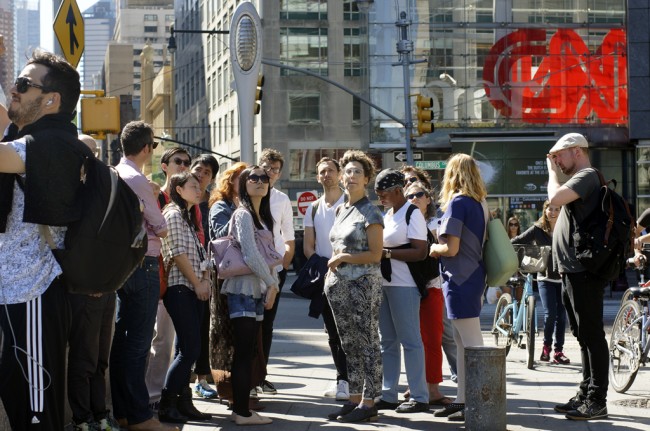
Participants gaze at the statue of Columbus 75 feet above the ground. | Photo by Justin Liu, Columbia University GSAPP
All of Elastic City’s artist-led walks and guided “ways” through the city seek to expand participants’ awareness of everyday places. In these events, routine pathways become focal points for new experiences, reinvigorated by invocations of abstract rituals or displaced rites in the vein of 1960s public performance art or Situationist movements.
A red-balloon beacon guided participants to the meeting point where Gavin Browning, Director of Events and Public Programs at GSAPP, waited for the group to arrive. The fountains provided a mild sound barrier between the street and the monument, a 75-foot column with a 13-foot statue of Christopher Columbus, where we took our initial refuge. Portions of the walk focused on particular areas of public activity, groups of visitors, or traffic flows within the circle, interspersed with breakout sessions for collaborative artistic exercises. These interludes throughout the walk provided moments for reflection in small groups.
Finley’s flow was spontaneous as she described the moment. She shared her inquiries and curiosities as they occurred to her, narrating a stream of connections formed between economic, ecological, and historical references. At one point in the survey of the circle, her attention fixed upon the water fountains, installed in 2005 by the firm responsible for the famous Bellagio fountains, which triggered associations with “speculation” in Las Vegas. She then led the audience through a series of encounters and recollections: the poisonous chestnut trees, the monument’s inauguration in 1892, and counter-clockwise traffic as a combat against time. For Finley, these reflections serve as “clues to read the space.” Celebrating the 400th anniversary of Columbus’ “discovery,” the monument was built in commemoration of commonly disputed events. This contentious event shaped our discussion of contemporary politics, with a nod of acknowledgment to the powerful corporate enterprises hovering all around the circle.
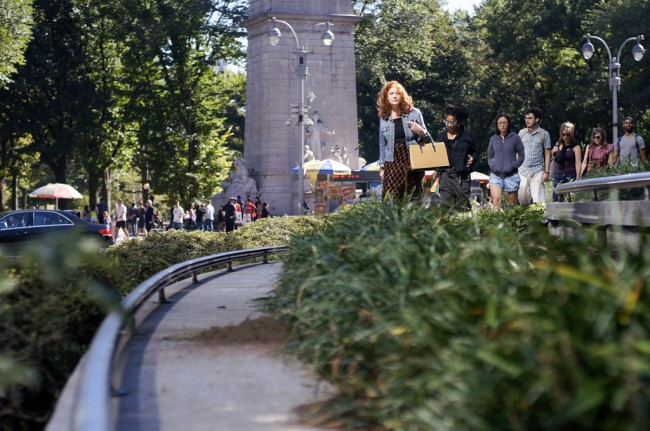
Circular “walkways” around the monument offer a different perspective | Photo by Justin Liu, Columbia University GSAPP
After gathering in the round to share our various thoughts and reactions, Finley aligned the group for a single-file circumnavigation of the circle’s penultimate ring. We entered an unmarked and quasi-accessible path just wide enough for one person, a walkway on the elevated ground that follows the ring of chestnut trees around the monument. Undeterred or detoured by those met along the way, Finley politely insisted that the group pass through the exact route of the marble pathway, striking up conversation with oblivious sunbathers and families lounging along the way.
Following the roundabout, Finley brought our attention to the monument’s structural oddities: its mirror-split totem of the hulls of the ships Niña, Pinta, and Santa Maria, its bronze illustrations, the problematic English and Italian translations on opposite sides of the pedestal. She noted how texts such as “the conquered ocean” conflict with the original Italian. We were invited to meander around the structure and investigate the scenes depicted in bronze before regrouping for small group exercises.
Finley instructed us to employ an exquisite-corpse method for conceiving a new monument through drawing and writing as a subtle critique of the circle. The small groups created about 15 drawings of mismatched mythical heads, architectural bodies, and exploded pedestals, which we briefly hung for exhibition on the monument’s wall. Afterwards, a volunteer from each group read aloud their Frankenstein-prose, short meditations on personal memories or new realizations.
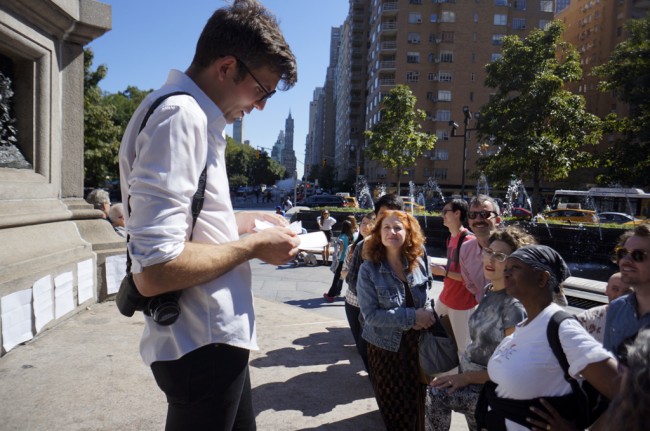
Reading aloud of poetry, exquisite-corpse drawings of new monuments behind | photo by Justin Liu, Columbia University GSAPP
In bursts of brisk walking to catch the street lights, we conducted a frenzied circumnavigation of the circle’s outer sidewalks until finally entering the inlet of Central Park. Under beams of afternoon light, Karen asked us each to film a 90-second video on our iPhones (or device of choice). As our necks strained from an hour of peering over heads to gaze at the statue and surrounding buildings, participants filmed the canopy of light created by the trees above.
On exiting the park, Finley requested each of us pick up a twig or feather, and guided us down into the subway station. An armed brigade of NYPD stood guard in front of a black van in the street, while two preachers praised their lord opposite the escalators. Below ground, we circled a focal point where marble inlays met in an octagram. Finley requested we arrange our foraged objects and our devices screen-up on the ground for a synchronized playback of the short films. The glimmering images of Central Park’s sunlit canopy spun like leaves in water, the screens making small portals to the sky within the sparse, dreamcatcher-like mandala on the ground.
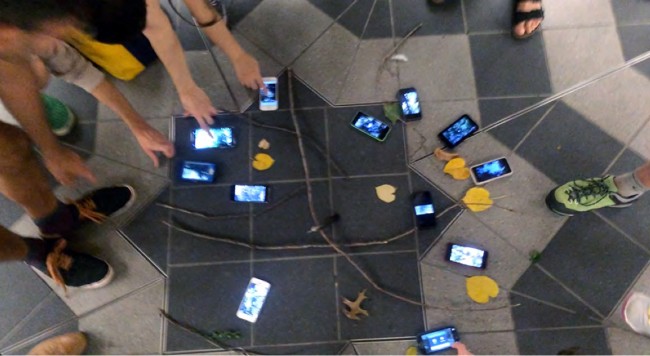
Underground at Columbus Circle’s subway station, an impromptu mandala of found objects and videos gathered in Central Park | photo by Max Lauter
Columbus Circle has had its share of contemporary performance and installation. Tatzu Nishi’s “Discovering Columbus” (2012) challenged issues of scale, public/private space, and commemoration in a performative but entirely different manner. Nishi’s piece raised pedestrians up to the height of the Columbus statue, offering attendees a linear narrative up and down a temporary staircase, pausing to consider the mundane grandeur of its surreal domestic setting. Finley is most often recognized for her transgressive performances, but on September 26th she was as much a participant as a guide, leaving the performance to unfold around us. Throughout the walk she remarked on her feelings of awe and wonder, which characterized her perspective as intimate, honest, and filled with curiosity and appreciation. The walk filtered Columbus Circle through the objects of Finley’s attention; the “happening” combined real-time narration with a sense of history and discovery. Creating our mandala highlighted how a place can radically transform even through simple, creative re-imaginings.
The views expressed here are those of the authors only and do not reflect the position of The Architectural League of New York.